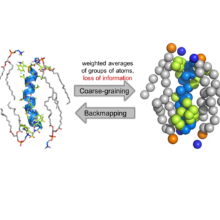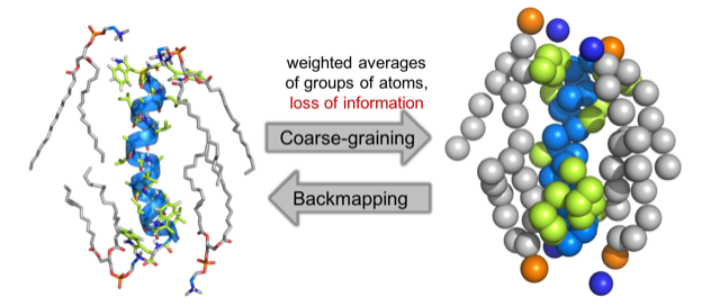In their project “Artificial intelligence meets molecular dynamics: certified machine learning for resolution transformation“, SimTech junior research group leaders Benjamin Unger and Kristyna Pluhackova, together with their PhD researchers, are working on a novel physics-informed machine learning framework (AI) for the reverse transformation of coarse-grained structures to atomistic level in molecular dynamics (MD) simulations. The method, universal for all types of molecules, will be made available to the community as an open-access python package following the FAIR data principles.
The project is part of the Artificial Intelligence Software Academy (AISA) at the University of Stuttgart as part of Cyber Valley. AISA is supported by the Ministry of Science, Research and the Arts of the State of Baden-Württemberg and trains specialists and addresses research questions at the interface between artificial intelligence, software engineering, and applications.
Coarse-graining (CG) of molecular representations for MD simulations has become a common practice allowing scientists to describe larger simulation systems over longer time periods. This process is, however, necessarily accompanied by a loss of structural information, e.g. on the stereochemistry and the relative orientation of the individual chemical groups, making the conversion to a higher-level resolution (also called reverse transformation or backmapping) a non-trivial operation.
Since state-of-the-art reverse transformation to atomistic level is time-consuming, can get trapped in wrong local minima, may fail to satisfy stereochemistry, and is error-prone to user interactions, Kristyna Pluhackova und Benjamin Unger want to establish a novel AI-based user-friendly methodology for backmapping. The goal is to speed up the procedure and avoid drawbacks of current state-of-the-art methodologies.
Kristyna Pluhackova is an expert in MD simulations at both all-atom and CG resolution. She has not only successfully parametrized widely used all-atom and CG force fields, but even developed the currently most often used methodology for reverse transformation, named backward.
Benjamin Unger is an expert in exploiting mathematical and physical structures in data in order to efficiently evaluate surrogate models and use a-posteriori error estimation techniques enabling certification of the surrogate models. He recently started to transfer these ideas to modern ML techniques.



